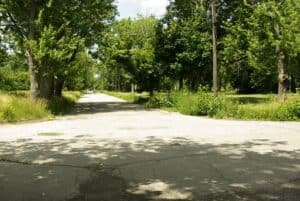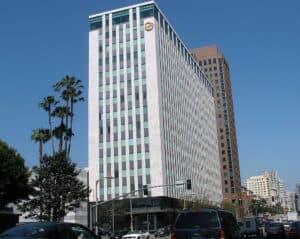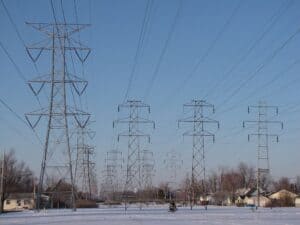
Hooker Chemical dumped 21,000 tons of toxic waste in Love Canal, but they may not be the true villains in this story.
The United States today is a country of two different people, liberals and conservatives. The partisan divide is stark and unnerving. But at bottom what exactly is it that divides us? The best definition I’ve heard comes from libertarian essayist P.J. O’Rourke who said, “Conservatives fear the government more than they do the corporations. Liberals fear the corporations more than they do the government.”
Good enough, but it’s a logical fallacy to conclude that if the government is bad, corporations must be good. Or if corporations are bad, the government is our champion. We might do well to remember that reality is more nuanced than that. For an interesting case in point, look no further than the tragedy of Love Canal, a neighborhood in Niagara Falls, NY that became the poster child for environmental disasters and a cause célèbre for the newly minted EPA back in 1978. I was headed there for the next stop on My American Odyssey.
Birth of a Waste Dump
The story of Love Canal begins back in the 1892 when a visionary named William T. Love proposed to connect the upper and lower Niagara Rivers by digging a 7-mile canal between them. He presented his scheme as an ambitious housing project to include a park, a hydroelectric plant and housing for 1 million people. Yet he only got 4,600 feet into the canal when an economic downturn gave his investors the jitters, and he lost his funding. Love went bankrupt and the project was abandoned.

Before it was a waste dump, the unfinished Love Canal was a recreational spot that attracted swimmers and skaters.
The canal gradually filled up with water and for the next twenty years became a recreational spot for swimmers and skaters. Then, in the 1920’s, the city of Niagara Falls began using it as a municipal dump site.
In the early 1940’s with the advent of World War II, the area became home to a number of defense factories. These factories generated lots of waste. Following the lead of the municipal government, they began dumping it into Love Canal.
So Love Canal was born as an entrepreneur’s vision, fell victim to an economic downturn, was pressed into service as a waste dump by the local government, and then appropriated by the federal government as a dump site for the army. In other words, by the time Hooker Chemical Company began using it as a waste dump in 1942, Love Canal had a long history of being used as a dump.

Love Canal is less than five miles from Niagara Falls. By the mid-1950’s the city was experiencing a boom and the school district was desperately in need of land.
What’s more, unlike previous users of the site, Hooker Chemical took precautions before dumping in it. They drained the canal and lined it with thick clay, and then, after filling the cavity with stacked barrels, they covered it up. They took care to bury the most potentially dangerous chemicals twenty-two feet deep and purchased the 70-foot-wide banks on either side of the canal as a buffer zone. At this point, Hooker Chemical could hardly be cited as a heedless corporate villain playing fast and loose with the public welfare.
What a Dollar Will Buy You
Hooker Chemical bought the site and used it until 1953, dumping 21,000 tons of chemicals there, after which they covered it with soil upon which vegetation began to grow. On the surface the area looked like nothing more than a tempting stretch of undeveloped land. But Hooker Chemical knew better, as did anyone else who bothered to consult the public records.

The Niagara Falls School District was warned by Hooker Chemical not to build a school on the dump site.
Love Canal is less than five miles from Niagara Falls State Park. By the mid-1950’s the falls were a major tourist attraction. In addition, industries were drawn to the area for its cheap hydroelectric power. By 1954 the City of Niagara Falls was experiencing a boom, the population was exploding, and the Niagara Falls City School District was in need of land to build new schools. They set their sites on the land owned by Hooker Chemical.
According to Eric Zeusse, who researched what happened next for Reason Magazine, Hooker Chemical was not evasive. They informed the school board in no uncertain terms that the site was a chemical waste dump, and that building a school there was a bad idea. Nevertheless, the school board persisted. The District was strapped for cash, and the land at Love Canal promised to be cheap.
Hooker Chemical continued to resist the school board’s overtures until the board began to hint at the possibility of using eminent domain
proceedings to seize the land. On October 6th, 1952 Hooker agreed to donate the land to the School District for a price of $1.
Punctured

The city was excavating sewer lines near the dump site and punctured holes in the protective clay walls.
Twenty-six years later, when the disaster that was Love Canal splashed onto the nation’s front pages, Hooker’s sale price of $1 was pointed to as evidence that the company was eager to unload the land on an unsuspecting school board.
The truth, however, was that eminent domain proceedings, had they been allowed to go forward, could’ve absolved Hooker of its liability. The decision to sell the land for a token price was more likely an attempt on the part of Hooker to warn future generations, through the instrument of the deed, about the dangers that lurked there. To that end Hooker was explicit:
Prior to the delivery of this instrument of conveyance, the grantee herein has been advised by the grantor that the premises above described have been filled, in whole or in part, to the present grade level thereof with waste products resulting from the manufacturing of chemicals.
Hooker went on to absolve itself of future liability by writing,
It is therefore understood and agreed that […] no claim, suit, action or demand of any nature whatsoever shall ever be made by the grantee, its successors or assigns, against the grantor, its successors or assigns, for injury to a person or persons, including death resulting therefrom, or loss of or damage to property caused by […] industrial wastes.

By 1978 birth defects such as cleft palates, clubbed feet and extra fingers afflicted 56% of Love Canal residents.
Critics of the company say that no such altruism existed on the part of Hooker, implying that Hooker was eager to wash its hands of the mess. But if so, why did Hooker’s attorney show up at a Board of Education meeting four years after the sale, when Hooker no longer had any interest in the land, to try to dissuade them from selling the land to developers for a subdivision. Hooker was adamantly opposed to any excavation for fear that it would puncture the clay cover containing the buried chemicals.
The City of Niagara Falls, for its part, evinced no such concern. For even as Hooker was parrying with the Board of Education in November of 1957, the city was excavating sewer lines near the site and punctured the protective clay walls. The sewer lines were being excavated to service a subdivision being built right next to the site.

When both the City and Hooker Chemical stonewalled her, neighborhood resident Lois Gibbs was galvanized to act. She raised the plight of Love Canal in the national consciousness.
At this point, the 99th Street School had been up and running for two years. 400 children were in attendance. During its first year, a twenty-five foot area crumbled, exposing toxic chemical drums, which then filled with rainwater and overflowed. Children were observed playing in the puddles.
In 1960 and 61, the School Board succeeded in unloading the land, dedicating the northern portion to the city and selling the southern portion at public auction. Like Hooker, the Board attempted to absolve itself of liability through the wording of the deed.
In 1962 the LaSalle Expressway was built near the site, during which additional holes were punctured in the protective cap, allowing rainwater to flow through, carrying toxic chemicals into the adjacent neighborhood, but because the neighborhood was not situated directly over the canal, residents were not informed of any danger. Fourteen years passed.

The people of Love Canal came out in protest against the inaction of the City of Niagara Falls and Hooker Chemical. Their voices were heard.
“An Extremely Serious Danger to Public Health”
In 1976 a pair of reporters for the Niagara Falls Gazette discovered toxic chemicals in the groundwater near Love Canal. In 1978 crusading liberal journalist Micheal Brown investigated further and discovered an alarming incidence of birth defects among residents living near the site. The New York State Health Department mounted its own investigation and found an abnormal incidence of miscarriages.
In August 1978 local resident Lois Gibbs, whose son suffered from epilepsy, asthma and a low white blood cell count, rallied the homeowners of Love Canal to appeal to the city to do something. She collected first hand accounts of strange odors and substances that surfaced in backyards, basement walls that seeped a thick, black ooze, and withering vegetation. The city refused to act.
At this juncture, the story appears to be one of an arrogant, self-serving government endangering the lives of its citizens through acts of appalling negligence while a stalwart company tries its best to avert the catastrophe. Grist for the mill of conservatives everywhere. But the story doesn’t end there.
Gibbs, in her attempt to get someone to do something, turned next to Hooker Chemical (now a subsidiary of Occidental Petroleum). Hooker dismissed her claims that chemicals at the dump site had anything to do with the cancers, birth defects, mental retardation and illnesses afflicting the neighborhood. When she persisted, they told her in affect that she would have to prove it in court. If need be, they could marshal a battery of attorneys to oppose her. She was appalled.
How bad was it? A survey conducted by the Love Canal Homeowners Association found that 56% of the children born from 1974–1978 had at least one birth defect. Still, circumstantial evidence does not prove guilt, and Hooker Chemical dug in, refusing to admit any responsibility whatsoever. For that matter, the city, adamantly refused even to acknowledge the problem. The mayor of Niagara Falls told angry residents, “There’s nothing wrong here [in Love Canal]!”

Suburbia aborted. Love Canal, the ghost of a suburban neighborhood. Houses were bulldozed and removed.
Faced with stonewalling from both parties, Gibbs didn’t know where to turn. By now, the New York State Health Commissioner had visited the neighborhood and stated that the dump site constituted “a public nuisance and an extremely serious threat and danger to [public] health”. He urged pregnant women and young children to leave the neighborhood. People began abandoning their homes at a loss.
Who could possibly help the homeowners of Love Canal?
Bi-Partisan Cooperation

In 1978 the EPA came to Love Canal along with the Federal Disaster Assistance Agency and started the clean up.
In 1970, eight years prior to the crisis at Love Canal, Republican president Richard Nixon submitted a plan for a federal agency tasked with protecting human health and the environment. The EPA was born.
Today the EPA is under fire from conservatives as a heavy-handed regulatory agency, and the Trump administration has gone further, putting adversaries of the agency in charge of it in an attempt to gut it from the inside. But in 1978 the times were different. A robust liberalism prevailed; the government was expected to act responsibly and forthrightly on behalf of the people. So in August 1978 President Jimmy Carter directed the EPA, along with the Federal Disaster Assistance Agency (forerunner of FEMA) to move swiftly to address the crisis at Love Canal.

The government’s response to Love Canal was the first time federal emergency funds were used for something other than a natural disaster.
Carter ordered home sump pumps sealed off and had channels dug to transport standing waste water to sewers. The EPA began careful testing of the ground water. More than 800 families were relocated and the federal government compensated them for their homes. It was the first time federal emergency funds were used for something other than a natural disaster.
And then in 1980 Congress acted. Working in a bi-partisan manner, it passed the Superfund act, which gave the federal government broad authority to clean up sites contaminated with hazardous waste, which they subsequently did at Love Canal.
At this point in the story, it appears the federal government was the knight in shining armor that rescued the victims of Love Canal from the cold-hearted cruelty of a wealthy chemical company. Grist for the mill for liberals everywhere. But that’s not the end of the story.

Largely in response to Love Canal, in 1980 the US Congress passed the Superfund act, which gave the federal government authority to clean up hazardous waste sites.
The federal government had no intention of bearing the financial burden of the clean up costs at Love Canal. The parties responsible would have to do that. The Superfund act authorized the EPA to identify the parties responsible for the contamination and compel them to clean it up. If the parties were slow to act, the agency was authorized to clean it up itself, using a special trust fund, and then seek redress. This is what happened at Love Canal.
So who was responsible for the pollution at Love Canal? Who would have to pay?
An Injustice
Conservatives are fond of the saying, “Guns don’t kill people. People kill people.” In this context the chemical waste at Love Canal was like a gun. As far as the company was concerned, they had locked it and put it away safely in a drawer. It was the Board of Education and the City of Niagara Falls that insisted on fiddling around with it until it went off and someone got hurt.
Liberals, on the other hand, feel strongly that corporations who profit from distributing deadly weapons among the general populace and then oppose efforts to safeguard them ought to be held responsible when those weapons cause harm. From a liberal perspective, this is more or less what happened at Love Canal. In many ways, this was case made by the Justice Department against Hooker Chemical and Occidental Petroleum, and in 1995 the company agreed to pay $125 million in restitution.
And what did the City and School Board have to pay?
Zero, zilch, nada.
This is the kind of thing that outrages conservatives and makes them so distrustful of government. Unfortunately for conservatives, the way some among them react can be counterproductive. In the case of Love Canal, a careful investigation of what actually happened would’ve revealed what appears to be an injustice perpetrated on the company by the federal government. For example, Hooker didn’t distribute its “deadly weapons” among the general population. When Hooker Chemical began dumping at Love Canal, it was not a residential neighborhood; it was a government waste dump. The City of Niagara Falls turned it into a residential neighborhood, against Hooker’s objections.

The City of Niagara Falls has lost 50% of its population from its peak. Hardly a reasonable target for financial redress.
What’s more, Hooker didn’t fight efforts to safeguard its chemical waste. On the contrary, it took what it thought were reasonable measures to bury and seal its waste. When the School Board threatened to compromise those efforts, Hooker stepped up and warned against it. In the eyes of many, given the evidence, Hooker was not negligent. Yet that was not the finding of the court.
So how did outraged conservatives react to this miscarriage of justice?
They blamed the residents and the media.
The Messy Truth
In 1998 Dr. Elizabeth Whelan, founder of the American Council on Science and Health, a right leaning advocacy group, wrote an editorial asserting that the media triggered hysteria among the residents when it called Love Canal a “public health time bomb”, and that illness among the residents was caused less by chemical waste than by stress – this in spite of an EPA study showing that 33% of the residents had undergone chromosomal damage.

Occidental Petroleum, which bought Hooker Chemical, is the third largest oil and gas exploration company in the world.
To be fair, stress was undoubtedly a contributing factor to the illnesses experienced at Love Canal, that only makes sense, but to downplay the effect of the chemical waste in an effort to absolve the company of any responsibility whatsoever borders on ludicrous and is needlessly divisive.
A left-leaning person confronted with such outrageous claims recoils and rushes to the defense of the opposition. But in this case, the opposition is not sinless either.
So why did the federal government decline to go after the School Board and the City of Niagara Falls? From a conservative perspective the answer is simple. Either the government was incompetent or it was conspiring to protect its fellow governments from accountability. In other words, governments are above the law, a supposition that drives conservatives around the bend.

In the eyes of many, the abundant hydroelectric power that once lured businesses to Niagara Falls is now a blight on the landscape. A honeymooner’s paradise?
But I suspect something else was at work. Throughout the 80’s and 90’s, as the case wound its way through federal courts, the City of Niagara Falls was in decline. Go there today and you will see evidence of it everywhere. Abandoned plants and crumbling factories dot the landscape. The city’s population has declined 50% from its peak in the 1950’s.
Far from being fiscally irresponsible, as conservatives would have it, the federal government sought to be reimbursed for its costs. Seeking redress from the City and School Board would’ve been an attempt to get blood out of a stone. Even had they succeeded, they likely would’ve bankrupted the city. On the other hand, Occidental Petroleum had the resources. It could’ve taken a hundred million dollar hit and pick itself up and dust itself off. Was this fair? Not at all. Was it pragmatic. Absolutely.
In the end, the story of Love Canal does not lend itself to an easy partisan reading. It is a story of heroes and villains on both sides. Arguably, what happened to Hooker Chemical and Occidental Petroleum was unfair. But then, what happened to the residents of Love Canal was unacceptable. And what happened to the City of Niagara Falls was a sad farce.
Drive around Niagara Falls to today. It’s a bombed out wasteland of derelict buildings and overgrown parking lots crisscrossed with high tension power lines. It’s hard to believe that this was once the top tourist destination in the United States, a shangri-la for honeymooners and society types. And then, in a few short years, it all went sour.
Whether you are the type who fears the government, or the type who fears the corporations, the story of Love Canal should be an object lesson. No one is clean, everyone carries some of the blame.
Reality is a mess.
Sources:
Beck, Eckardt C. The Love Canal Tragedy, EPA Journal, January 1979, 5 October 2012.
Blum, Elizabeth D. Love Canal Revisited : Race, Class, and Gender in Environmental Activism. Kansas: University Press of Kansas. 2008.
Brown, Michael H. Love Canal and the Poisoning of America, The Atlantic, Volume 244, No. 6; pp 33-47, December 1979, 5 October 2012.
Englehaupt, Erika. Happy Birthday Love Canal, Chemical & Engineering News, Vol 86, No 46, pp 46-53, 17 Nov 2008, 6 Oct 2012.
Gibbs, Lois. Love Canal: The Story Continues, Gabriola Island: New Society Publishers, 1998.
Jordan, Michael. Hush, Hush: The Dark Secrets of Scientific Research. Buffalo: Firefly Books, 2003.
Wikipedia contributors. “Love Canal.” Wikipedia, The Free Encyclopedia. Wikipedia, The Free Encyclopedia, 30 Sep. 2012. Web. 7 Oct. 2012.
Wikipedia contributors. “Niagara Falls, New York.” Wikipedia, The Free Encyclopedia. Wikipedia, The Free Encyclopedia, 23 Sep. 2012. Web. 7 Oct. 2012.
Zuesse, Eric. Love Canal: The Truth Seeps Out, Reason Magazine, February 1981, 5 October 2012.
Previous stop on the odyssey: Danvers, MA //
Next stop on the odyssey: Cleveland, OH
Video: Mike Dickman: A Historical Tour of Love Canal
About the author: Malcolm Logan is a freelance writer who specializes in US travel and US history, designing one day driving tours, seeking out interesting US destinations and exploring US adventure travel.
Image credits:
Hazardous waste drum, Brandon Bourdages; 1920’s ice skaters, German National Archives; Niagara Falls, Ronald Molino; Businessman warning, Ishay Botbol; Pollution drain, Lamiot; Cleft palate, Trelawney; Clubbed feet, Richard Mansoner; Extra fingers, Metro.co.uk; Lois Gibbs, Yoopernewsman; Love Canal protester, Public Domain; Abandoned parking lot in Love Canal, Buffalutheran; Abandoned Street in Love Canal, Buffalutheran; Love Canal cleanup; EPA/Superfund; Rusted barrels, EPA/Superfund; Superfund sign, Public Domain; Looking down 99th St in Love Canal, Buffalutheran; Abandoned Building, Gt90v12; Occidental Petroleum Building, Cool Caeser; Power lines, Public Domain; Looking into Love Canal, Buffalutheran






2 comments
As always, solid report with solid facts: good work!
Thank you.
this is so sad